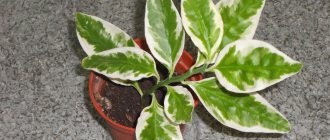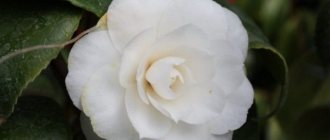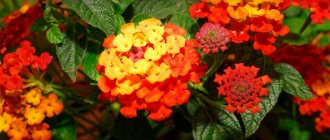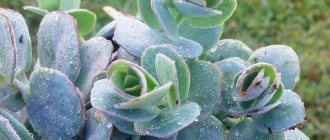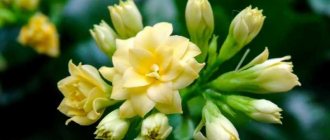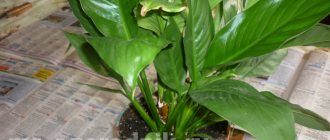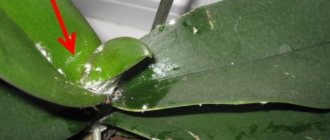Genus lantana (Lantana) unites approximately 150 species of evergreen shrubs and is directly related to the verbena family. Under natural conditions, such plants can be found in tropical areas of America. Today, it can also be found in many parts of the world, because this plant quickly acclimatizes in places with similar climatic conditions.
If conditions are favorable for the growth of lantana, then it can multiply quite quickly, displacing almost all other plant species. For this feature in India they began to call it the “curse of the planters.” However, in areas with cold winters, such a plant freezes out, so it is better known there as an indoor plant.
At home, people most often grow lantana camara or spiny lantana, as well as many of its hybrids created by crossing with other species of closely related plants. In the wild, this flower has the shape of a bush and reaches a height of 150 centimeters. When grown indoors, lantana is quite compact and can reach a height of only 50 centimeters.
Lantana camara
The plant has become so popular because of its bright and unusual flowers. The fact is that from the moment of opening to ripening, the flowers change their color several times. So, after the flowers just open, they are yellow, then they become pink, and after they ripen, they become burgundy or red.
It has erect tetrahedral shoots, the surface of which is covered with small spines. More recently, a new garden form of Aloha has been grown, which has drooping, soft stems. It is most often grown in hanging baskets or garden containers.
The dark green leaves on the stem are arranged oppositely and have jagged edges. The foliage below is pubescent along the veins. By rubbing the leaf a little, you can feel a spicy and very pleasant smell that can fill the entire room.
Growing such a flower indoors will not cause any special problems. It is possible to form lantana into a not very large tree or bush. This plant is fast growing, so it is useful to trim it regularly, which also stimulates the formation of inflorescences.
Lantana blooms from spring and all summer. In the fall, she begins a dormant period that will last until next spring. It is recommended to move it to fresh air in the warm season (for example, to the garden or balcony).
Fleshy black berries are formed on faded inflorescences. It is important to remember that they are poisonous, and therefore this flower is not suitable for children. To prolong flowering, it is recommended to remove faded inflorescences, at the same time you will prevent the setting of poisonous fruits.
This flower is often grown as an annual garden plant and used to decorate flower beds located in sunny places. The fact is that bright sunlight promotes more abundant flowering, and the bush in such a place will be more compact.
What does lantana look like?
Lantana is a genus of perennial plants belonging to the Verbenaceae family. It is widespread in South and Central America, with some species found in Africa and Southeast Asia. According to various sources, the genus contains from 140 to 170 species.
Lantana grows very quickly in nature
The name of the plant was given by the famous Swedish systematizer Carl Linnaeus. The ancient Romans called viburnum "Lantana". Apparently, the botanist’s choice was influenced by the characteristic corymbose shape of the inflorescences.
Lovers of indoor plants appreciate lantana for its unusual flowering. In addition to the fact that it is long-lasting (from April to October), the petals gradually change color. This happens literally before our eyes, within 2–3 days. At the same time, you can see scarlet, orange, bright yellow, and white flowers on the bush. They are collected in numerous dense inflorescences in the shape of an umbrella or an almost regular ball. Characterized by a pleasant aroma. If lantana has enough light, it can bloom continuously almost all year round.
Lantana inflorescences are in the shape of an almost regular ball
After flowering, small round berries appear, each containing two seeds. Unripe fruits are green, they cannot be eaten, they are poisonous. Ripe berries where lantana grows are eaten, most often added to various desserts. The taste is reminiscent of mulberry.
Unripe lantana fruits are poisonous
The plant branches intensively. In nature, it is a shrub or tree reaching 3 m in height. Lantana is characterized by its growth rate, so it needs regular pruning at home. You can shorten it to about 30–50 cm in height. The shoots are covered with smooth greenish-gray bark, sometimes with frequent thorns.
The opposite leaves are slightly pubescent. The average length is about 4–5 cm. They feel quite hard and rough to the touch, as if they were made of plastic. The leaves are shaped like nettles. The edge is cut in the same way with teeth. The veins are clearly defined.
The leaves also emit a specific tart aroma that not everyone likes. It contains notes of mint, lemon, camphor, and some smell an onion “amber.” A light touch on the flower is enough for it to spread throughout the room. However, others really like the smell. Dried lantana leaves are even used to make sachets.
Lantana's leaves are also pretty, but this is not the main advantage of the plant.
The leaves are also not very pleasant to taste, they give off bitterness. The plant secretes a special toxin that covers them with a thin film. This feature reliably protects lantana from attacks by domestic animals.
In countries where lantana is not an endemic plant, it is a real disaster. It grows very quickly, developing new territories and displacing the local flora. States are forced to take tough measures against the foreign “invader.” For example, in Australia and South Africa it is officially prohibited to plant lantana in parks and gardens, even private ones.
Where the climate allows and where it is not prohibited, lantana is widely used in landscape design.
Lantana has many nicknames. It is called “nettle” (for the characteristic shape of the leaves), “maiden word”, “changeable rose”, “switching flower” (for the “inconstancy” of color), “bacon and eggs”, “Spanish flag” (for a similar color scheme) . Other unofficial names are “coast rose”, “big sage”, “small berry”.
Lantana petals change color literally before our eyes
History of appearance
Lantana is a plant that came to Russia from Latin America. Due to its ability to grow quickly, it received the nickname “the curse of the planters.” Beautiful shrubs with fragrant inflorescences literally occupied lands intended for planting other crops. But in the gardens they did not fight the dominance of shrubs; on the contrary, they planted them with pleasure.
Blooming lantana
Lantana was first described in 1737 by Carl Linnaeus in his work Genera Plantarium. The scientist gave the flower the same name that the Viburnum Gordovina shrub had by that time (the plants have very similar inflorescences).
Interesting to know! Due to the external similarity of lantana leaves to nettles, the shrub is sometimes called nettle.
Types popular among amateur gardeners
Of the many species of lantana, only a few have adapted to home conditions. Most of the plants found in the apartments of amateur gardeners are selection hybrids, the “parent” of which is Lantana spinosa. Many of them have larger and single-colored flowers. The creators also “adjusted” other parameters. Such lantanas grow much more slowly and rarely reach a height of more than 30 cm.
Natural varieties:
- Lantana spinous, spinous or vaulted (camara). The stems are spiny, hence the name. The leaves are rich green in color, egg- or heart-shaped, covered on the inside with short, soft, white “lint.” The “aroma” is specific, not very pleasant. The petioles are long. The color of the petals changes from bright yellow to scarlet or from pinkish to peach. Flowering occurs from May to October. The diameter of the inflorescences is about 5 cm.
- Lantana Sello (selloviana). The shoots are thin, flexible, and look like whips. Leaves with a slight edge on the reverse side. The flowers are very small (3–5 mm in diameter), pinkish-purple. The bases of the petals are bright yellow.
- Lantana Montevidensis (montevidensis). The shoots are as flexible and curly as those of lantana Sello, becoming woody at the base. The flowers are brighter, lavender or purple. The leaves are small (2–3 cm in length). The diameter of the inflorescences is 2–3 cm. There are natural mutations with white or yellowish flowers.
- Lantana rugulosa. Shrub 1–1.2 m high. Shoots are straight, covered with small thorns. The leaves are dark green, the front side is rough to the touch. The flowers are pale purple.
- Lantana sage (salviifolia). An intensively branching shrub about 2 m high. The shoots are thin and curly. The veins stand out very sharply. The shade of the petals varies from pastel pink to pale purple.
- Blood red lantana (sanguinea). The height of the bush is about 1.5 m. The shoots are thin and erect. The leaves are large (6–7 cm), oval with a pointed tip. The flowers are red-orange.
- Lantana hybrid (hybrida). Compact shrub 70–80 cm high. The leaf blade is “wrinkled”. Lemon yellow buds change color to red-orange.
- Lantana variegata. It is distinguished by variegated leaves with pale green, white and silver spots. This artificial modification greatly weakens the plant, so it needs more careful care.
Photo gallery: “natural” types of lantana grown at home
Lantana variegata stands out not only for its abundant and long-lasting flowering, but also for its variegated foliage. Lantana hybrida, despite its name, is a natural variety.
Lantana has blood-red monochromatic inflorescences
Lantana sage-leaved has very bright flowers. Lantana wrinkled owes its name to the appearance of the leaf blades.
Lantana monewidea is very similar to lantana Sello, but its flowers are of a more saturated color
Lantana Sello has very small flowers and not so dense inflorescences
Lantana spinosa is most often found in the apartments of gardeners
The achievements of breeders are very impressive. The material for most experiments is lantana spinosa.
Photo gallery: achievements of breeders
Lantana Ice Queen, Snow, White Dwarf - snow-white flowers, very pure shade
Lantana Tutti Frutti - yellow gradually changes to orange, then to pink and deep purple
Lantana Tukan - pale yellow or cream flowers bloom in early spring
Lantana Esperanta Pink - petals of a very delicate mauve shade
Lantana Calipso Gold - shiny, chrome-plated yellow petals
Lantana Bandana Pink - pink or crimson flowers, among all breeding hybrids it differs in size (up to 80 cm in height)
Lantana Samanta - bright lemon-colored flowers and lime-colored leaves
Lantana Sonja - flowers shimmer in different shades of pink and yellow
Lantana Naida - snow-white petals with a bright yellow base
Lantana Schloss Ortenburg - very beautiful saffron flowers
Lantana Sunkiss, Coctail, Po - petals are brick red, copper or terracotta
Lantana Aloha has pale golden flowers.
Lantana Spreading Sunset - a very interesting creeping plant, flowers of different shades of yellow and orange
Lantana Pink Queen - yellow buds with a pinkish tint and pink-crimson flowers
Lantana Cloud Of Gold and Goldensonne - rich golden yellow petals
How to create an optimal microclimate for a plant
Lantana is a tropical plant, but it has adapted surprisingly well to the radically different microclimate of modern apartments from its usual one. It tolerates low air humidity easily. The only thing the plant needs is a lot of light.
Table: optimal conditions for growing lantana
| Factor | Recommendations |
| Location | Window facing west, east, southeast, southwest. Lantana is very afraid of cold drafts. In summer, you can take it out onto the open balcony or into the garden, protecting it from wind and rain. |
| Lighting | A very light-loving plant. Can tolerate some direct sunlight (3-5 hours a day), but the best option is bright, diffused light. In winter, you cannot do without additional lighting. Use regular fluorescent or special phytolamps. |
| Temperature | In summer - 22–27ºС. Below 20ºС is undesirable. During the rest period - 5–12ºС. This is an indispensable condition for abundant flowering for the next season. The plant is gradually brought out of hibernation, ensuring a temperature of about 14–18ºС in early spring. |
| Air humidity | It exists calmly at the standard 40–50%. In hot weather, daily spraying is recommended. At the same time, you need to be careful - overmoistening is harmful for lantana. And make sure that the drops do not fall on the flowers. You can raise the indicators in another way - place wet pebbles, expanded clay, sphagnum moss in a tray, place containers with water nearby, and purchase a special device. |
The main requirement of lantana for keeping conditions is good lighting.
Interesting Facts
- The leaves of the flower have an ambiguous aroma. Some people find it very unpleasant, reminiscent of the smell of cat urine. And some people fill pillows with them and use them as flavoring agents.
- The flowering of one bud lasts no more than three days.
- Unripe fruits are very toxic and dangerous for animals and humans.
- During the process, the color of the rubble changes from white to orange or red.
- Used for medicinal purposes. Helps with dermatitis, wounds and bites. For rheumatism and colds, a decoction of lantana is used.
- In Australia it is considered one of the most formidable and difficult to remove weeds.
- In open ground in southern territories it manifests itself very aggressively, displacing other plants. In India they even call it the “curse of the planters.”
- The plant is very beautiful and quite unpretentious. Achieving optimal conditions is not difficult. And abundant flowering will always please.
Transplant procedure
Since lantana has a different growth rate, replanting it is an annual procedure. The best time for this is early spring, before the active growing season begins. If you don’t choose a large pot or tub, the powerful root system can fill the container and in less time, the plant will need to be replanted “out of schedule.” Roots protruding from the drainage holes clearly indicate that the need is ripe. If the clear signal is ignored, lantana simply will not bloom.
The plant has no special requirements for soil quality. The main thing is that it is loose enough to allow air and water to pass through well. The acid-base balance is neutral - pH 6.6–7.0. Store-bought soil is quite suitable for flowering indoor plants. Sometimes there is also a special soil for Verbenaceae, but rarely.
You can mix the substrate yourself:
- fertile turf, leaf soil, humus, fine sand (2:4:1:1);
- peat chips, universal soil for flowering indoor plants, coarse river sand or perlite (1:2:1);
It is quite difficult to find special soil for Verbenaceae, but regular substrate for flowering indoor plants is also suitable for lantana.
If it is difficult to replant lantana due to its size (it is difficult to remove the plant from the pot), limit yourself to replacing the top layer of substrate 5–7 cm thick. In other cases, replanting is carried out by transshipment, keeping the earthen ball intact if possible.
It is easier to remove lantana from the pot if you water the plant thoroughly half an hour beforehand.
During the replanting process, do not forget that you need to create a thick (4–5 cm) layer of drainage at the bottom of the new pot and cut off 2–3 mm of the roots that have formed a solid “pile” at the bottom with a sharp, clean knife. The transplanted lantana is watered moderately and sent to light partial shade for 3–5 days to minimize the stress received by the plant.
Experienced gardeners recommend planting 2-3 lantana bushes in one pot. Firstly, if they are of different varieties, such multi-colors look very elegant and original. Secondly, for an unknown reason, this stimulates branching - the plants increase in volume by 1.5–2 times.
Sources
- A working list of all plant species. Lantana camara // The Plant List https://www.theplantlist.org/tpl1.1/record/kew-107934
- A working list of all plant species. Lantana montevidensis // The Plant List https://theplantlist.org/tpl1.1/record/kew-1081813
- Hessayon D.G. All about indoor plants // M.: Kladez-Buks, 20054
- State catalog of pesticides and agrochemicals approved for use on the territory of the Russian Federation as of July 6, 2022 // Ministry of Agriculture of the Russian Federation https://mcx.gov.ru/ministry/departments/departament-rastenievodstva-mekhanizatsii-khimizatsii- i-zashchity-rasteniy/industry-information/info-gosudarstvennaya-usluga-po-gosudarstvennoy-registratsii-pestitsidov-i-agrokhimikatov/Cover photo: pixabay.com
Important nuances of flower care
For tropical exotics, lantana is completely unpretentious. In nature, this is a real weed. The gardener will not be required to arrange “dances with tambourines” around the plant. But you can’t just put the pot on the windowsill and forget about it.
Watering
Blooming lantana needs plenty of watering. But you can’t turn the soil in a pot into a swamp - rot develops quickly. Wait until the substrate dries to a depth of 1–2 cm. Lantana, which does not have enough moisture, quickly drops its buds. If it is not hot outside, one watering every 3-5 days is enough. After 35–40 minutes, be sure to drain excess moisture from the pan.
Don't forget about other water treatments. Lantana loves them very much. While the plant is not blooming, you can wash it in the shower; the rest of the time, regularly wipe the leaves with a damp sponge or soft cloth, removing dust.
Fertilizer application
Abundant flowering takes a lot of energy from lantana. Therefore, she needs regular feeding. Any universal fertilizer for flowering indoor plants will be suitable. Once every 12–15 days, it is watered with the prepared solution, reducing the dose of the drug by half compared to that recommended by the manufacturer. You should not overuse fertilizing, otherwise it will begin to intensively increase green mass to the detriment of flowering.
Lantana needs regular feeding; a universal fertilizer for flowering indoor plants is quite suitable.
Lantana also responds positively to natural organic matter. You can use, for example, an infusion of fresh cow manure diluted with water 1:15. It is better to carry out such fertilizing before flowering. Excess nitrogen can prevent flower buds from forming.
Trimming
Radical pruning of lantana is carried out in early spring, after the end of the dormant period. You can combine it with a transplant. First of all, they get rid of old side shoots that are unsightly stretched out and “bald” from below. Of the remaining ones, pinch out each of the top 2-3 leaves - this has a positive effect on the abundance of flowering.
Bonsai enthusiasts have successfully miniaturized lantana
During the flowering period, do not forget to get rid of dried buds. In their place, new ones are formed.
The lantana crown is easy to shape. Here the florist is limited only by his own imagination. The most common options:
- Ball-shaped bush. Shorten the shoots to create the desired configuration. Then, every year, remove about a third of the length, and also get rid of poorly placed shoots that clearly extend beyond the selected contour.
- Standard tree. It is formed from plants aged three years or older, whose shoots have become lignified. Select one upright, strongest branch; all others located below the desired height of the “trunk” are cut to the base. You will definitely need support. Above, the crown is formed in accordance with the selected configuration. The “trunk” is regularly cleaned of emerging lateral growth.
- Ampelous plant. Choose lantana varieties with thin, creeping shoots. It is enough to place the plant in a hanging pot and periodically shorten the vines to the desired length. For greater bushiness, cut every third shoot in half in the spring.
The lantana “tree” looks very impressive
“Trees” look very impressive, into the crown of which several shoots of other varieties are grafted. The unusual variety of colors immediately attracts attention.
Rest period
Lantana needs a cool winter. This is a prerequisite for flowering for the next season. From mid-autumn, watering is gradually reduced (one procedure every 12–14 days is enough), and fertilizing is stopped altogether.
Lighting requirements do not change. For a “resting” lantana, they look for the brightest place in the apartment. In most of Russia, there is not enough natural light, so you have to use fluorescent or special phytolamps.
Some selection hybrids bloom almost continuously, so they do not need wintering. They need to be moved to the window sill facing south so that the leaves do not touch the cold glass. There is no need to protect from direct sunlight - at this time it is not so active.
Video: appearance and important nuances of plant care
Recent Entries
Lilac perennials that are beautiful, compact and do not crowd out other plants Why when buying seedlings you should not take the sellers’ word for it and how to determine the age of the plant using 3 signs Tomato seedlings have turned purple or whitish: why the color has changed and how to save the plants
What to consider before purchasing
Lantana is easy to care for, but there are several important points:
- photophilous. The plant does not bloom in low light; cuttings also require bright, indirect light for development.
- Heat-loving, does not tolerate cold drafts.
- It grows very quickly. Flowers form at the ends of shoots and pinching, formation delays flowering, but they are necessary to obtain a compact, beautifully shaped bush.
In South Africa and Australia, the imported lantana plant is rapidly replacing native species. The cultivation of these shrubs is prohibited in parks and private gardens.
- Unripe fruits contain a weakly toxic substance.
- The flower has a specific smell. Plants of each variety smell slightly different. Leaves also emit scent, not just flowers. The aroma appears when touched. There are options from lemon, honey, mint to the smell of camphor, garlic or onion.
- When the inflorescence dries out, the small flowers fall off and litter not only the window sills, but also the plants surrounding the lantana.
- Indoor lantana flowers especially attract whiteflies. For some owners, this becomes a reason to refuse breeding. It is good to treat flowers preventively in spring and autumn.
Typical mistakes of a beginning gardener
Most unintentional mistakes by the grower will not kill the lantana. But they negatively affect its decorative effect. The plant may refuse to bloom altogether. This is the most obvious signal - something doesn’t suit him. But there are other alarming symptoms that you need to be able to interpret.
Table: how lantana reacts to grower mistakes
| What does the plant look like? | What is the reason |
| Lack of flowering. | Failure to provide the right conditions (especially temperature) during the dormant period, deficiency of nutrients in the soil. Either the flower has not been replanted for a long time. |
| The leaves become smaller, turn pale, and the shoots become thinner. | Lack of light. |
| The tips of the leaves turn brown, dry out, and the leaf blades curl into a tube. | Too little watering and/or very low indoor humidity. |
| Pale spreading spots on leaves. | Burn from direct sunlight. |
| The leaves turn black. | Abundant watering combined with low indoor humidity. The flower needs to be sprayed more often, and watering, on the contrary, should be reduced. |
| Leaves fall. | Autumn leaf fall is a natural phenomenon. During the active growing season, it can be triggered by heat or low humidity. |
| The bases of the shoots turn black and the soil becomes moldy. | Low temperature combined with high humidity. The development of rot is almost inevitable. |
Common diseases and pests
Lantana does not have any specific pests. Of the insects that feed on the sap of plants, for some reason the whitefly is especially partial to it. The appearance of pathogenic fungi is often provoked by the grower himself by watering the plant too much.
It is easier to prevent any problem than to deal with unpleasant consequences. Simple preventive measures will help reduce the risk of infection to a minimum:
- placing newly acquired collection items in quarantine for 3–4 weeks;
- weekly inspection of flowers (you can even use a magnifying glass) and immediate isolation of those that show suspicious signs;
- placing pots on the windowsill without being too crowded;
- regular ventilation of the room and wiping the leaves from dust;
- using only sterilized substrate, clean tools and pots;
- proper watering of plants (once every 2-3 weeks you can replace ordinary water with a pale pink solution of potassium permanganate);
- removal of dried leaves and buds, regular sanitary pruning;
- weekly irradiation of leaves with a quartz lamp on both sides (two to three minutes is enough).
Table: diseases and pests typical of lantana
| Disease or pest | External manifestations | Control measures |
| Root rot | The bases of the shoots turn black, spots of the same color appear on the leaves. The soil becomes moldy and gives off an unpleasant putrid smell. | The disease is treatable only in the early stages of development. Then all that remains is to throw the flower away.
|
| Gray rot | Beige spots on the leaves, covered with a layer of fluffy grayish “lint” with small black splashes. Then these areas of tissue soften, the leaves fall off, and the buds turn black. |
For prevention, every 2-3 months you can spray the plants with a 0.1% solution of Fundazol, Bayleton, Topsin-M. |
| Rust | Small oval “pads” of yellow-orange color on the underside of the leaves, which over time become covered with a layer of “pollen” of the same shade. |
|
| Brown spot | Light olive spots on the front side of the leaves. Those at the bottom suffer first. Gradually, the leaf plate turns yellow, and a gray-brown coating appears on the underside. |
|
| Aphid | Small insects of yellow-green or black-brown color, clinging to the underside of leaves, tops of shoots, and flower buds. |
|
| Mealybug | Spots of whitish coating, the plant seems to be covered in flour. Leaves, flowers and buds quickly dry out and fall off. |
For prevention, once a month, spot-apply any preparations based on Neem tree oil to the leaves. |
| Whitefly | Small whitish butterflies flutter from the plant at the slightest touch. |
|
Photo gallery: diseases and pests that affect lantana
For unknown reasons, the whitefly is very partial to lantana.
Mealybugs may seem like a harmless pest, but they are not.
Aphids are one of the most “universal” pests of indoor plants; they will not refuse lantana either
All leaves affected by brown spot should be cut off and destroyed.
“Pollen” on the leaves are spores of a pathogenic fungus
Leaves affected by gray rot quickly dry out and fall off
Root rot can only be treated in the early stages of the disease.
Reproduction at home
The easiest way to grow new lantana is by rooting cuttings. The grower receives planting material (even in excess) during the pruning process. It is rarely propagated by seeds due to the difficulties associated with their acquisition. At home, they bud infrequently; moreover, the characteristic varietal characteristics of the “parents” are rarely transmitted to the “descendants”.
Cuttings
A lantana stalk is the tip of a semi-lignified shoot 8–12 cm long. They are cut only from completely healthy plants.
Lantana cuttings appear in abundance at the grower after each pruning
- Allow the sections to dry for 2-3 hours outdoors.
- Powder them with any powdered root formation stimulator (Zircon, Heteroauxin) and plant them in small pots filled with moist peat, deepening them 2–3 cm. Some gardeners recommend rooting cuttings in pure perlite or vermiculite. First remove any interfering lower leaves.
- Place the containers in your home mini-greenhouse or create “greenhouses” using plastic bottles or plastic bags. Provide a constant temperature of about 20ºC and bright, indirect light for 10–12 hours a day. Regularly ventilate the plantings and spray the drying substrate with a spray bottle. After a week, gradually reduce the level to 12–15ºС.
- When the cuttings take root and begin to grow, remove the greenhouse.
- For greater compactness and bushiness, regularly pinch the cuttings throughout the year, thus removing the growing point and 1-2 top leaves every 2-3 months.
Lantana cuttings rooted in spring will bloom at the end of this summer
Video: rooting lantana cuttings
Germination of seeds
Seeds are sown at any time from the New Year to the beginning of spring.
Lantana seeds are quite rare on sale; growing them at home is also not easy.
- For 2 hours, pour the seeds with hot (55–60ºС) water with the addition of an activated carbon tablet or several crystals of potassium permanganate. Then place it in a solution of any biostimulant (succinic acid, potassium humate, Epin, Kornevin) for the same time.
- Wrap them in a damp cloth or gauze, wetting it as it dries.
- Fill shallow containers with a mixture of peat chips, perlite, and vermiculite. Moisten and level the substrate.
- Sow the seeds when sprouts appear. Lightly sprinkle fine sand on top, cover with glass and plastic wrap. Provide them with a temperature of 22–25ºС and bottom heating. Spray the soil as it dries.
- Seedlings appear in 10–15 days. When a pair of true leaves has formed, lower the temperature to 14–16ºС. Once they reach a height of 8–10 cm, plant them in separate pots filled with soil suitable for adult plants. Then take care as usual. After two weeks, it is recommended to pinch and feed the plant for the first time.
Lantana seedlings need fairly low temperatures for proper development.
Young lantanas resemble herbaceous plants rather than bushes or trees. They bloom longer and more abundantly than adult specimens. Therefore, many gardeners, instead of bothering with replanting, prefer to rejuvenate the plant.

